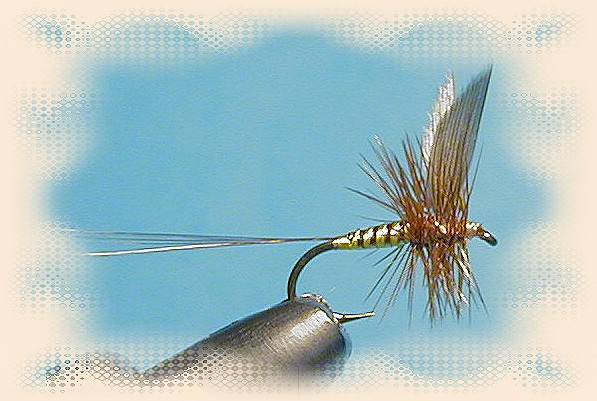Flight's Fancy is one of many old flies which has
both wet and dry versions,(dry shown above). The
fly is portrayed as a dry fly in Mary Orvis
Marbury's turn of the century book, and shown
as a wet fly in Ray Bergman's Trout.
Both E.C. Gregg and J. Edson Leonard give no clues
as to the wetness or dryness of ANY of the flies
listed in their books, but so many flies were
done both ways in those days that there probably
is no point in showing a type. I know when I was
young there seemed to be both wet and dry versions
of virtually all the popular flies of the day.
Mary Orvis Marbury includes this fly in a list
of "Frederic M. Halford's Floating Flies For
Dry Fly Fishing," so the guess is that it was
originally a dry. She has this to say about
the English flies that were imported over here
in the beginning:
"Criticisms have been made in the past,
upon some papers that we contributed to
the "Forest and Stream" and other
publications, that in these papers we
'wrote of English flies that were of no
use in this country.' This is a sweeping
assertion that bears upon its face unfairness,
for no one at all versed in the history of
trout flies can deny our indebtedness to
British anglers for many of our most valued
patterns of trout flies. In future years I
hope that we may be able to return these
favors. At one period nearly all the
tackle-dealers in America were of Scotch,
English, or Irish birth, and had brought
with them to this land their knowledge of
the implements used in the "old country;"
the flies they sold were all imported, and
so the fishermen of this country came to
know and use the flies most favorably
known abroad. In time we invented methods
of our own, copied the insects of our streams
and lakes, and experienced fly-dressers grew
up in this country; but it is nonsense and
ungrateful to be unwilling to acknowledge our
indebtedness to the older country. Its leisure
class is greater than our own, and has thought
out many things and experimented in many ways
that we reap the benefit of. Some waters of
America are quite unlike those of Great Britain,
and so require different flies but other streams
and conditions are similar, and we are coming
more and more, in the long-settled portions of
the States, to adopt the delicate flies and
gossamer leaders found effective in England."
Truer words were never spoken, especially when
one looks at the Halford flies listed along with
Flight's Fancy, flies like the "Golden Ribbed
Hare's Ear, Grannom, Little Marrayat, and
Wickham's Fancy. These flies hold up well
to this day, as does Flight's Fancy. Surprisingly,
even the recipe comes through the years largely
unscathed, indicating, I think, the respect held
for these venerable flies. The ones I've tied
here I don't imagine are appreciably different
from the originals, and I'm very confident both
flies would catch fish today. The only differences
I see in recipes over the years involve the hackle,
which is either brown (Ray Bergman), or ginger
(J. Edson Leonard and E.C. Gregg). Now that I
think of it, the ginger probably makes a bit
more sense, but I tied mine with brown per Ray
Bergman. The wet version is shown below.

|


